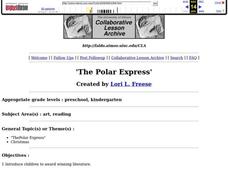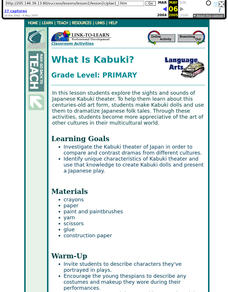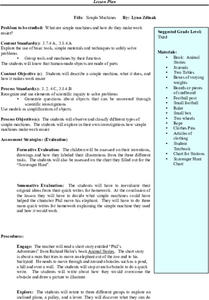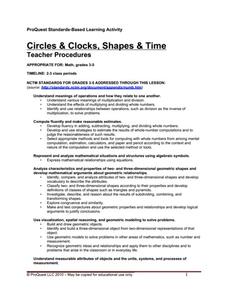Curated OER
The Polar Express
Students listen to the picture book, The Polar Express, and review events that happened in the story. Students draw pictures of what they might have seen on the way to the north pole.
Curated OER
Neanderthals on Trial
Students examine a drawing of a Neanderthal artifact that was found in Solvenia in 1996. They attempt to identify the artifact in small groups, and present their ideas to the whole class. They discover what scientists believe the...
Curated OER
Transverse Wave Demonstrator
Students discover the properties of waves in Chemistry and Physics. In groups, they develop and build their own device to demonstrate transverse waves. They complete their tests, record the results and discuss the conclusions with the...
Curated OER
Is It Alive?
Eighth graders define the boundaries of living organisms. They determine what makes something a living organism and identify factors that constitute "living." Pupils write a conclusion about the evidence they found that yeast is alive...
Curated OER
Mystery of the Senses-Vision
Students view six optical illusions and explain why the visual system might interpret them the way it does. They explore how illusions distort our sense of perspective, because they deceive us into seeing what we expect to see. ...
Curated OER
What Are the Needs of Living Things?
In this living things worksheet, students will write down two facts about what a living thing needs to survive. Using these facts, students will draw a conclusion to how those needs are met.
Curated OER
Artifact Puzzles
Pupils role-play the position of archaeologists to determine the different types of artifacts. They cut out a drawing of their object and connect them with their classmates objects. They write an essay about their object and where it was...
Curated OER
Classroom Conservation
Fourth graders suggest ways paper and other natural resources can be used and recycled in the classroom. Students conduct a investigation into paper use and make distinctions among observations, conclusions (inferences), and predictions.
Curated OER
Off to Work We Go
First graders distinguish between jobs that provide goods and those that provide services. They role-play jobs and analyze whether their job provides services or produces goods. They draw pictures and write a description of a job in each...
Curated OER
Study of the Cell
Students draw a diagram to show the fluid mosaic model of a membrane. They explain how hydrophobic and hydrophilic properties help membranes hold their shape. They identify the functions of different cell membrane proteins as well.
Curated OER
Raptor Poster Project
Learners create posters about raptors. They synthesize information they read about raptors and select a raptor. They draw a picture of their raptor and include facts relating to where it lives, characteristics, feeding habits, size, name...
Curated OER
The Class Garden Essay
Fifth graders use a class garden as inspiration for a specific writing assignment. They conduct research into different types of flowers in photo images taken with a digital camera. Students write a creative essay and draw a picture to...
Curated OER
Simple Machines
Third graders listen to a short story entitled, "Phil's Adventures" from a book called Animal Stories. They stop at each obstacle in the story and do a quick write about how they would overcome the obstacle and draw a picture to...
Curated OER
"First Day of School - Make a Puzzle"
Third graders create a puzzle piece to be included in a class puzzle. They are given one puzzle piece, and they decorate it using symbols/drawings which are personal to them such as hobbies, interests, or self-portrait. The pieces are...
Curated OER
Following the North Star
Students give examples of the impacts of science and technology on the migration and settlement patterns of various groups. They draw stars
explaining how the North Star was used to give directions on the Underground Railroad.
Curated OER
Tadpoles to Frogs!
Third graders observe the tadpoles/frogs and draw a picture in their journals every week to monitor its growth with 100% accuracy. They observe tadpoles/frogs and record at least two changes or the observations the tadpole undergoes...
Curated OER
Graphing Sound
Students formulate an understanding of sound as a vibration and draw their graph as carefully as possible on their observation sheet. They also record how they made the sound and and a description of the sound. Finally, students cut out...
Curated OER
Circles and Clocks, Shapes and Time
Students work in groups to research clocks and practice telling time. For this telling time lesson, students use the computer program ProQuest to study circles, including radius and diameter, and practice drawing circles using a compass....
Curated OER
Two Ways of Life
Learners visit Internet sites to compare ways of life of Indians on western Texas frontier and U.S. military men at Texas forts, and draw pictures to illustrate clothing, transportation, weapons, and shelter of both Indians and U.S....
Curated OER
Japanese Printmaking
Students review their prior knowledge on the topic of printmaking. Individually, they draw three ideas for their own print and watch a video about the techniques used by the Japanese. In groups, they move from station to station to make...
Curated OER
What Is It?
Students view photographs of an area where artifacts where recently taken. Using the artifacts, they work together to try to determine the occupations, diet and other information about a specific group of people. They write an artifact...
Curated OER
Industrial Revolution
Eighth graders examine the conditions of workers during the Industrial Revolution. Using the internet, they select three personal statements from workers and others to develop their own conclusions. They answer discussion questions about...
Curated OER
Ecological Cycles Part 1
Knowing about the hydrologic cycle is the first step to understanding the carbon cycle. Upper graders discuss the earth's water content, polar ice caps, and the concept of the ecological cycle as it applies to carbon, nitrogen, and other...
Curated OER
Text to Self Connections
Students read the story Ira Sleeps Over and write something about the end of the story that they have a connection with in their own life. In this text to self lesson plan, students look for something that helps them relate to the story...
Other popular searches
- Nonfiction Draw Conclusions
- Draw Conclusions in Reading
- Draw Conclusions Lesson
- Draw Conclusions Reading
- How to Draw Conclusions
- Infer and Draw Conclusions
- Draw Conclusions in Literacy
- Draw Conclusions in Fiction
- Fiction Draw Conclusions
- Draw Conclusions Worksheet

























